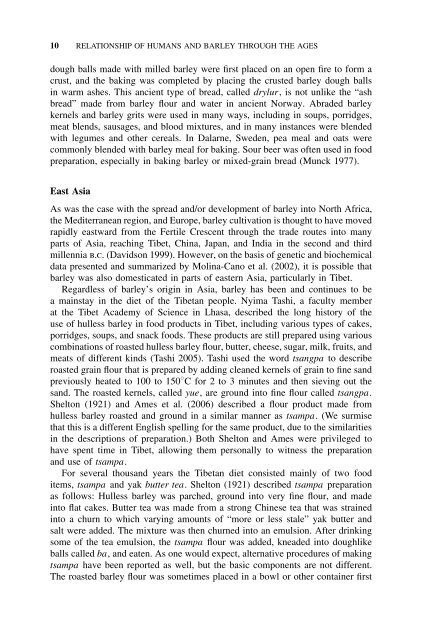Barley for Food and Health: Science, Technology, and Products
Barley for Food and Health: Science, Technology, and Products
Barley for Food and Health: Science, Technology, and Products
Create successful ePaper yourself
Turn your PDF publications into a flip-book with our unique Google optimized e-Paper software.
10 RELATIONSHIP OF HUMANS AND BARLEY THROUGH THE AGES<br />
dough balls made with milled barley were first placed on an open fire to <strong>for</strong>m a<br />
crust, <strong>and</strong> the baking was completed by placing the crusted barley dough balls<br />
in warm ashes. This ancient type of bread, called drylur, is not unlike the “ash<br />
bread” made from barley flour <strong>and</strong> water in ancient Norway. Abraded barley<br />
kernels <strong>and</strong> barley grits were used in many ways, including in soups, porridges,<br />
meat blends, sausages, <strong>and</strong> blood mixtures, <strong>and</strong> in many instances were blended<br />
with legumes <strong>and</strong> other cereals. In Dalarne, Sweden, pea meal <strong>and</strong> oats were<br />
commonly blended with barley meal <strong>for</strong> baking. Sour beer was often used in food<br />
preparation, especially in baking barley or mixed-grain bread (Munck 1977).<br />
East Asia<br />
As was the case with the spread <strong>and</strong>/or development of barley into North Africa,<br />
the Mediterranean region, <strong>and</strong> Europe, barley cultivation is thought to have moved<br />
rapidly eastward from the Fertile Crescent through the trade routes into many<br />
parts of Asia, reaching Tibet, China, Japan, <strong>and</strong> India in the second <strong>and</strong> third<br />
millennia b.c. (Davidson 1999). However, on the basis of genetic <strong>and</strong> biochemical<br />
data presented <strong>and</strong> summarized by Molina-Cano et al. (2002), it is possible that<br />
barley was also domesticated in parts of eastern Asia, particularly in Tibet.<br />
Regardless of barley’s origin in Asia, barley has been <strong>and</strong> continues to be<br />
a mainstay in the diet of the Tibetan people. Nyima Tashi, a faculty member<br />
at the Tibet Academy of <strong>Science</strong> in Lhasa, described the long history of the<br />
use of hulless barley in food products in Tibet, including various types of cakes,<br />
porridges, soups, <strong>and</strong> snack foods. These products are still prepared using various<br />
combinations of roasted hulless barley flour, butter, cheese, sugar, milk, fruits, <strong>and</strong><br />
meats of different kinds (Tashi 2005). Tashi used the word tsangpa to describe<br />
roasted grain flour that is prepared by adding cleaned kernels of grain to fine s<strong>and</strong><br />
previously heated to 100 to 150 ◦ C <strong>for</strong> 2 to 3 minutes <strong>and</strong> then sieving out the<br />
s<strong>and</strong>. The roasted kernels, called yue, are ground into fine flour called tsangpa.<br />
Shelton (1921) <strong>and</strong> Ames et al. (2006) described a flour product made from<br />
hulless barley roasted <strong>and</strong> ground in a similar manner as tsampa. (Wesurmise<br />
that this is a different English spelling <strong>for</strong> the same product, due to the similarities<br />
in the descriptions of preparation.) Both Shelton <strong>and</strong> Ames were privileged to<br />
have spent time in Tibet, allowing them personally to witness the preparation<br />
<strong>and</strong> use of tsampa.<br />
For several thous<strong>and</strong> years the Tibetan diet consisted mainly of two food<br />
items, tsampa <strong>and</strong> yak butter tea. Shelton (1921) described tsampa preparation<br />
as follows: Hulless barley was parched, ground into very fine flour, <strong>and</strong> made<br />
into flat cakes. Butter tea was made from a strong Chinese tea that was strained<br />
into a churn to which varying amounts of “more or less stale” yak butter <strong>and</strong><br />
salt were added. The mixture was then churned into an emulsion. After drinking<br />
some of the tea emulsion, the tsampa flour was added, kneaded into doughlike<br />
balls called ba, <strong>and</strong> eaten. As one would expect, alternative procedures of making<br />
tsampa have been reported as well, but the basic components are not different.<br />
The roasted barley flour was sometimes placed in a bowl or other container first

















